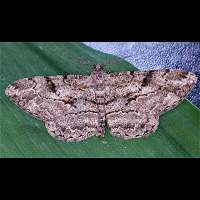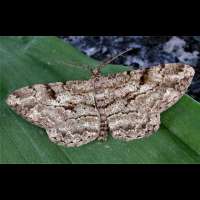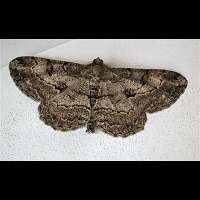Willow Beauty (Peribatodes rhomboidaria)
It's not very easy to identify the Willow Beauty. It looks a lot like some other beauties and all share one characteristic: the markings on the wing do not offer much for the eye to get a hold of. This doesn't only effect people, but many of their daytime enemies as well. Whatever the background it is sitting on, a beauty is hard to discover. The Willow Beauty has a dark spot near the edge of the forewing, which narrows towards the body and becomes a line. More to the top of the wing is another, smaller line. This brown line is very wavy. Just at twothirds of the wing the two lines merge. If possible also look at the line at the underwing: it runs almost straight from one edge to the other. Alas, there are specimens completely grey or blackish, usually without any markings. These are very hard to identify at times. The legs are banded, like the legs of most other beauties. The wingspan varies a lot and may be anything from 40 to 48 mm.
The eggs hatch in August. The caterpillar is quite dull: uniformly greyish, reddish or yellowish brown. It has some dark markings on the back, which may be in a diamond shape. The head is brown and the caterpillars may reach a length of some 40 mm. The larvae feed in August en September and then hibernate. In spring they'll finish their development en pupate. The pupa hangs from a silk wire from a branch of the foodplant. The foodplants may be birch or hawthorn in nature, but in gardens they include ivy, privet, plum and traveller's joy.
In most of Britain the Willow Beauty is on the wing from mid-June to mid-August. In southern England a second generation may appear, flying about to the end of September. The moth may be seen during the day resting on tree trunks, fences and walls, where it is surprisingly well camouflaged. Both males and females happily come to light and during the day rest in the vicinity of lights that have been on all night. A common species in England, Wales, Ireland and Southern Scotland. In Central and Northern Scotland this is a local species only, getting scarcer to the north. Not found in Orkney, the Hebrides or Shetland.
It's not very easy to identify the Willow Beauty. It looks a lot like some other beauties and all share one characteristic: the markings on the wing do not offer much for the eye to get a hold of. This doesn't only effect people, but many of their daytime enemies as well. Whatever the background it is sitting on, a beauty is hard to discover. The Willow Beauty has a dark spot near the edge of the forewing, which narrows towards the body and becomes a line. More to the top of the wing is another, smaller line. This brown line is very wavy. Just at twothirds of the wing the two lines merge. If possible also look at the line at the underwing: it runs almost straight from one edge to the other. Alas, there are specimens completely grey or blackish, usually without any markings. These are very hard to identify at times. The legs are banded, like the legs of most other beauties. The wingspan varies a lot and may be anything from 40 to 48 mm.
The eggs hatch in August. The caterpillar is quite dull: uniformly greyish, reddish or yellowish brown. It has some dark markings on the back, which may be in a diamond shape. The head is brown and the caterpillars may reach a length of some 40 mm. The larvae feed in August en September and then hibernate. In spring they'll finish their development en pupate. The pupa hangs from a silk wire from a branch of the foodplant. The foodplants may be birch or hawthorn in nature, but in gardens they include ivy, privet, plum and traveller's joy.
In most of Britain the Willow Beauty is on the wing from mid-June to mid-August. In southern England a second generation may appear, flying about to the end of September. The moth may be seen during the day resting on tree trunks, fences and walls, where it is surprisingly well camouflaged. Both males and females happily come to light and during the day rest in the vicinity of lights that have been on all night. A common species in England, Wales, Ireland and Southern Scotland. In Central and Northern Scotland this is a local species only, getting scarcer to the north. Not found in Orkney, the Hebrides or Shetland.







